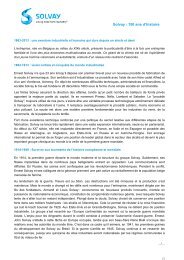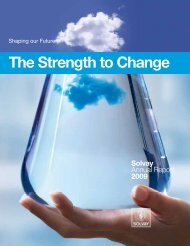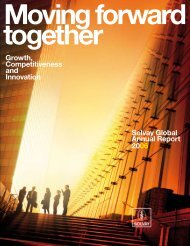THE FUTURE, - Solvay
THE FUTURE, - Solvay
THE FUTURE, - Solvay
You also want an ePaper? Increase the reach of your titles
YUMPU automatically turns print PDFs into web optimized ePapers that Google loves.
REPoRt > Innovation elsewhere<br />
open innovation<br />
the new paradigm<br />
FOR DR. HENRY CHESBROUGH OF <strong>THE</strong> UNIVERSITY OF CALIFORNIA, INNOVATION IS <strong>THE</strong> MOST<br />
IMPORTANT SOURCE OF ORGANIC GROWTH WITHIN A COMPANY.<br />
<strong>Solvay</strong> live – Dr. Chesbrough, how<br />
would you define ‘Open<br />
Innovation’?<br />
Dr. Chesbrough – Using external<br />
ideas and technologies in your own<br />
company; allowing unused internal<br />
ideas and technologies to be used<br />
by others in their companies; and<br />
finally, having a business model that<br />
determines what external ideas to<br />
bring in and what internal ideas to<br />
let out.<br />
SL – Why is this so important?<br />
Dr. C. – Innovation is the most<br />
important source of organic growth<br />
for a company. It helps grow<br />
revenues and reduce costs by<br />
improving the internal operations<br />
and by increasing the overall<br />
circulation of ideas and<br />
technologies. Limited investments in<br />
new fields should also be made,<br />
since it is from today’s innovators<br />
that the market leaders of tomorrow<br />
will be found.<br />
SL – What do you see as the main<br />
challenges facing a traditional<br />
company?<br />
Dr. C. – Many companies have great<br />
12<br />
Express portrait<br />
success with a ‘closed innovation<br />
model’ in which the flow of internal<br />
ideas allows them to develop new<br />
products and businesses,<br />
generating great pride in the internal<br />
R&D process but creating resistance<br />
to using external ideas. In a ‘closed<br />
model’ all the decisions for R&D<br />
activities are made at the budgeting<br />
stage in a top-down manner whilst<br />
in the ‘open model’ the ideas and<br />
decisions are made at the periphery<br />
of the corporate ecosystem – often<br />
with outside partners over whom we<br />
have no control.<br />
SL – Have you an example of open<br />
innovation that might apply to us?<br />
Dr. C. – Air Products developed a<br />
technology to incinerate the waste<br />
products of their processes but the<br />
internal business units of the<br />
company did not wish to spend the<br />
money to install it in their plants.<br />
The technology therefore was<br />
licensed out. The licensee then<br />
started to make money (thus<br />
externally validating the technology)<br />
and it was only then that Air<br />
Products businesses decided to use<br />
it themselves.<br />
Best known for his book Open Innovation: The New<br />
Imperative for Creating and Profi ting from Technology,<br />
Dr. Henry Chesbrough is the Director of the Center for<br />
Open Innovation at the Haas School of Business at the<br />
University of California at Berkeley, which he joined in<br />
2003 after six years teaching at Harvard Business School.<br />
His most recent book is Open Business Models (2006).<br />
Experience shows that tough times<br />
tend to push companies into<br />
exploring such new innovative<br />
business models.<br />
SL – Have you a particular<br />
recommendation for us?<br />
Dr. C. – Perhaps the most important<br />
is to understand the IP (intellectual<br />
property) ‘deadweight loss’ in the<br />
company, by looking at what<br />
percentage of <strong>Solvay</strong>’s patents are<br />
actually being used in one or more<br />
of the company’s businesses.<br />
Unused patents are underutilised<br />
resources that could become<br />
revenue generators if released to<br />
the outside world. As in the Air<br />
Products case, they may even<br />
provide external validation of<br />
underappreciated internal<br />
technology.<br />
“Innovation<br />
is the most<br />
important<br />
source of<br />
organic growth<br />
within a<br />
company.”


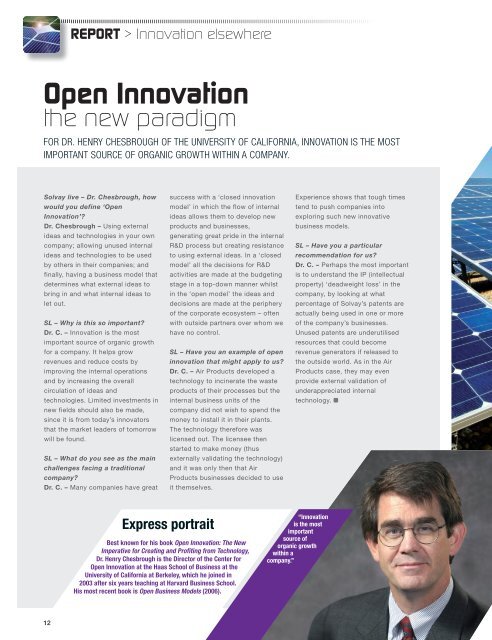

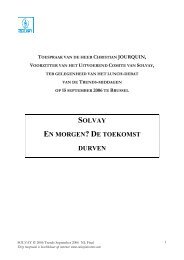
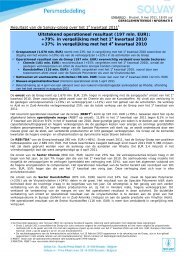

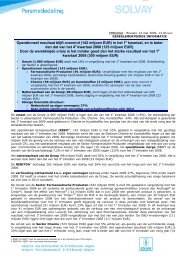


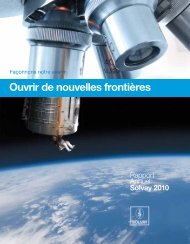
![PROC.1 [LETTRE] - Solvay](https://img.yumpu.com/16585746/1/184x260/proc1-lettre-solvay.jpg?quality=85)
